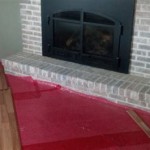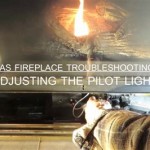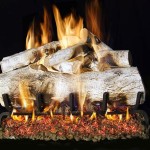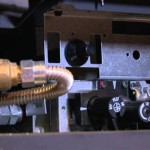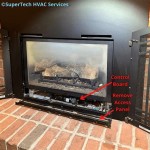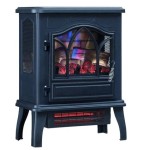How to Put Fake Logs in a Gas Fireplace
Gas fireplaces offer a convenient and clean alternative to traditional wood-burning fireplaces. However, the aesthetic appeal of a crackling wood fire is often missed. This is where fake logs, also known as ceramic logs or refractory logs, come into play. These logs are designed to mimic the appearance of real wood while being heat-resistant and safe for use in gas fireplaces. Proper installation of these logs is crucial for both safety and optimal performance of the fireplace. Improper placement can impede gas flow, leading to incomplete combustion and potentially dangerous carbon monoxide buildup. It can also damage the logs themselves, leading to premature wear and tear. This article provides a comprehensive guide on how to correctly arrange fake logs in a gas fireplace.
The process of placing fake logs is not simply about aesthetics. It directly impacts the efficiency and safety of the fireplace. The logs are strategically designed with grooves and channels that direct the gas flames, creating a realistic burning appearance. Blocking these channels can lead to inefficient heating and an unnatural flame pattern. Furthermore, the logs are made from materials that can withstand high temperatures, but they are not indestructible. Direct exposure to the gas burner or improper support can cause them to crack or crumble over time.
Understanding Your Gas Fireplace and Log Set
Before attempting to arrange the fake logs, it is essential to understand the type of gas fireplace and log set you have. Gas fireplaces generally fall into two categories: vented and ventless (or vent-free). Vented fireplaces require a chimney or vent to exhaust combustion byproducts, while ventless fireplaces are designed to burn more cleanly and do not require external venting. The type of fireplace will dictate the specific requirements for log placement.
Vented fireplaces typically allow for more flexibility in log arrangement as there is less concern about oxygen depletion or carbon monoxide buildup. Ventless fireplaces, on the other hand, are more sensitive to log placement. Incorrect arrangement can disrupt the oxygen-fuel ratio, leading to incomplete combustion and the production of carbon monoxide. It is imperative to follow the manufacturer's instructions precisely when arranging logs in a ventless fireplace.
The log set itself also varies. Different sets contain varying numbers and sizes of logs, each designed for a specific placement within the fireplace. Some sets may include a designated base log, while others may feature a top log or a series of smaller kindling-like pieces. Each log typically has a specific orientation, often marked with a number or letter, indicating its intended position. Attempting to force a log into a space where it does not belong can damage the log or compromise the overall arrangement.
It's also critical to identify the burner type. Common burner types include linear burners, which are typically long and narrow, and grate burners, which resemble a traditional fireplace grate. The burner type will significantly influence the log arrangement, as the logs need to be positioned to allow for proper gas flow from the burner.
Consult the owner's manual for both the fireplace and the log set. These manuals provide detailed instructions and diagrams specific to your models. They typically include illustrations showing the correct log placement, as well as information about safety precautions and maintenance procedures. Failing to consult these manuals can lead to incorrect installation and potential safety hazards.
Step-by-Step Guide to Placing Fake Logs
After understanding your fireplace type and log set, the following steps outline the process of placing the fake logs.
Step 1: Safety First. Before beginning, ensure the gas supply to the fireplace is turned off. Locate the gas shut-off valve, typically near the fireplace or in an adjacent room, and turn it to the "off" position. Allow the fireplace to cool completely before handling the logs.
Step 2: Clean the Fireplace. Remove any debris, ash, or old log remnants from the fireplace. A clean fireplace will allow for better airflow and ensure the logs sit properly on the burner or grate. Use a brush or vacuum cleaner to thoroughly clean the area.
Step 3: Identify Log Placement. Refer to the owner's manual or the provided diagrams to identify the correct placement of each log. Look for markings on the logs, such as numbers or letters, that correspond to specific locations in the fireplace. Most log sets are designed to be arranged in a particular order and configuration.
Step 4: Start with the Base Log. If your log set includes a designated base log, place it first. The base log usually sits directly on the burner or grate and provides a foundation for the other logs. Ensure the base log is stable and properly aligned with the burner.
Step 5: Position the Remaining Logs. Carefully position the remaining logs according to the instructions. Ensure that the logs do not directly obstruct the gas burner ports or openings. The logs should be arranged to allow for adequate airflow and flame distribution. Avoid jamming the logs together, as this can restrict gas flow and create an unnatural flame pattern.
Step 6: Verify Log Stability. Once all the logs are in place, carefully check their stability. Ensure that each log is securely supported and will not shift or fall during operation. If any logs are unstable, readjust their position until they are secure.
Step 7: Double-Check Gas Flow. Before turning on the gas, visually inspect the log arrangement to ensure that no logs are blocking the burner ports or gas flow. Make sure there is adequate space around the burner for the flames to ignite and spread. Incorrect log placement can lead to incomplete combustion and the production of carbon monoxide.
Step 8: Test the Fireplace. Turn the gas supply back on and ignite the fireplace. Observe the flame pattern and ensure that the flames are burning evenly and naturally. If the flames are uneven, smoky, or excessively high, turn off the gas and readjust the log placement. It may take several adjustments to achieve the optimal flame pattern.
Key Considerations for Optimal Log Placement
Beyond the basic steps, several key considerations can further optimize log placement for safety, efficiency, and aesthetics.
Flame Impingement: Avoid direct flame impingement on the logs. While the logs are heat-resistant, direct and sustained exposure to the flames can cause them to deteriorate over time. The logs should be positioned to allow the flames to dance around them, rather than directly hitting them. Flame impingement can also create excessive soot, which can discolor the logs and the fireplace surround.
Airflow and Ventilation: Proper airflow is essential for efficient combustion and to prevent the buildup of carbon monoxide. Ensure that the logs are arranged to allow for adequate airflow around the burner and throughout the fireplace. Do not block any vents or openings that are designed to provide air to the combustion process. In ventless fireplaces, in particular, maintaining adequate ventilation is crucial for safety.
Aesthetics and Realism: While safety and efficiency are paramount, the aesthetic appearance of the log arrangement is also important. Consider the overall symmetry and balance of the log arrangement. Try to create a natural-looking fire scene that mimics the appearance of a real wood fire. Experiment with different log placements to achieve the desired aesthetic effect, while still adhering to the safety guidelines and manufacturer's instructions.
Regular Inspection and Maintenance: Periodically inspect the logs for signs of damage, such as cracks, chips, or excessive soot buildup. Damaged logs should be replaced to prevent safety hazards and maintain the efficiency of the fireplace. Clean the logs regularly with a soft brush to remove dust and soot. Also, inspect the burner and gas lines for any leaks or damage. Regular maintenance will ensure the safe and efficient operation of your gas fireplace for years to come.
Proper log placement is not just about making the fireplace look nice; it is about ensuring the safety and efficiency of the appliance. By following these guidelines and consulting the manufacturer's instructions, users can achieve a beautiful and safe gas fireplace experience.

How To Put In A Gas Log Set For Fireplace Ron Hazelton

How To Install Gas Logs 13 Steps With S Wikihow

How To Arrange Gas Fireplace Logs All Valley Repair

How Long Do Gas Logs Last To Replace Fireplace
How To Arrange Gas Logs Howstuffworks

How To Install Gas Logs 13 Steps With S Wikihow

Vented Gas Logs Heater Or Decorative Bart Fireside

How To Put In A Gas Log Set For Fireplace

How To Select And Install A Gas Fireplace Log Set Fireplaces Direct Learning Center

Warming Trend Update Gas Logs To Improve Performance And Appearance Walton
Related Posts

